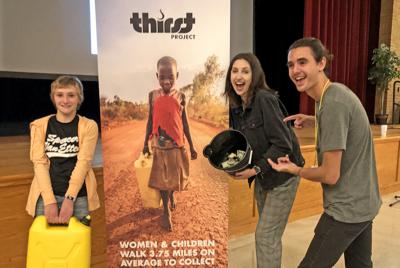Jaylene Noviello, a senior at Spencer-Van Etten High School, is Lt. Governor of Division 22, a part of Key Club, International, this year. As part of her duties, she attended ICOBN, an international conference of Key Club representatives in Baltimore, MD, this past summer and brought back to the SVE High School an outreach activity that impressed her at the conference.
Thirst Project brings clean water via deep wells to communities in 13 countries where the residents have only muddy, filthy water to drink, often contaminated with human or livestock feces. Dirty water causes a variety of diseases, from cholera to diarrhea to parasites and fungal infections. All of these are easily prevented when clean drinking and bathing water are available. A sobering statistic: unsafe drinking water is the number one killer of children worldwide.
In addition to the water being of poor quality, women and children in water-poor locations have to walk, on average, about four hours a day to get the water and bring it home. They carry the water in five-gallon jerry jugs that weigh 44 pounds. Once home, the water must be boiled to make it safe to drink, and even then, some of the contaminants are not properly destroyed; sometimes people still get sick even from boiled water. Children occupied so many hours by hauling water do not get much education, which impacts their future earning prospects.
Two representatives from Thirst Project, Makayla Martinez and Paul Rivas, from California, are fall interns on a national tour to bring this message of the global need for clean water. Rivas showed a video of one of the teens who founded Thirst Project and her trip to Swaziland, a tiny country on the northeast border of South Africa. It is known for two grim statistics—the lack of clean water for its citizens and a very high rate of HIV infection.
Treatment for those with HIV is complicated by not having access to clean water. Thirst Project directs its fundraising efforts at students, because they realized that no other organization was reaching this age group. They do it by simply sharing the story of how needed clean water is and the life-changing results when a community gets clean water.
Swaziland now calls itself the Kingdom of Eswatini. Thirst Project chose Eswatini to focus many of its resources on, because by providing clean water, they could simultaneously combat the ravages of HIV. In 2012 Thirst Project set a ten-year goal of clean water coverage for the entire country of Eswatini. They are at 80 percent now, so they are on track to meet their goal of 100 percent coverage by 2022. They do this by raising money. Every cent donated by students goes directly into a fund to finance drilling a deep well of 200-300 feet, to ensure a continuous supply of clean water to a community. One well costs $12,000, and they emphasize that all other costs of Thirst Project are covered by corporate donations. (Morton Salt is one of their larger donors.)
Martinez and Rivas are on a mission to let school groups know about the need for clean water and to ask students to raise money for this good cause in whatever ways they choose. Some groups run dedicated fundraisers; others just collect spare change. Rivas told the student body at SVE during an assembly that $1 provides clean water for one person. $25 will provide water for that person’s entire life. In a surprise move, they grabbed a bucket and challenged the students at the assembly to donate whatever spare change they might have in their pockets to help this important cause. This “one minute challenge” netted over $129, which Martinez said was the most they’d ever collected from a student presentation. As students and teachers in the auditorium did not know that the bucket would be passed, following the assembly there was a steady stream of additional donations from people who went back to lockers and wallets to pull out a little cash to help this cause.
For those interested in learning more about Thirst Project, “the world’s largest youth water organization,” according to its web site, just google thirstproject.org and it comes right up. The following statistics are from their website: to date they have raised $10 million, served over 400,000 people with 3,018 projects. The sad reality is that worldwide, every 21 seconds a child dies of water-related disease. Many of these deaths can be prevented.
A full jerry can of water weighs 44 pounds and the average distance it must be carried is 3.75 miles. Children spend an average of six to eight hours walking for water each day, which is why they can not attend school. Women are not able to engage in work for income, to help support their families, because they are carrying water for them instead.
Every time Thirst Project builds a well, they also ensure that a pit latrine is either present and working or they build one. This provides proper sanitation and prevents water contamination from open defecation practices. Thirst Project also teaches something very basic—proper hand washing techniques to stop the spread of disease. Handwashing is something every school child learns in the United States, where most people have access to clean water, but is new to people who have no water to spare on washing.
The borehole wells that Thirst Project builds are hand pump wells, and they teach the community how to maintain and fix them should they need repairs. Keeping it low-tech is important because the wells do not rely on an external power source or paying to fuel a power source. Solar panels have not proved to be a good investment so far because when they break the community cannot fix them, and they are at a high-risk for theft.
Thirst Project believes, from initial data, that when properly maintained the wells they drill should last for 40 years or more. Rainwater catchment systems and protecting springs (where they are options) are two other facets of Thirst Project’s work.
For donors, Thirst Project will provide community information on the well they help support, GPS coordinates, photos of the well and community, and a personalized thank-you video from the community. This video shows how they used to get water, its murky quality, and the new, clean water from the exact well a donor funds. Big smiles from everyone on the video and a much healthier community, actually saving lives, are the rewards for donors.













(0) comments
Welcome to the discussion.
Log In
This is a space for civil feedback and conversation. A few guidelines: 1. be kind and courteous. 2. no hate speech or bullying. 3. no promotions or spam. If necessary, we will ban members who do not abide by these standards.